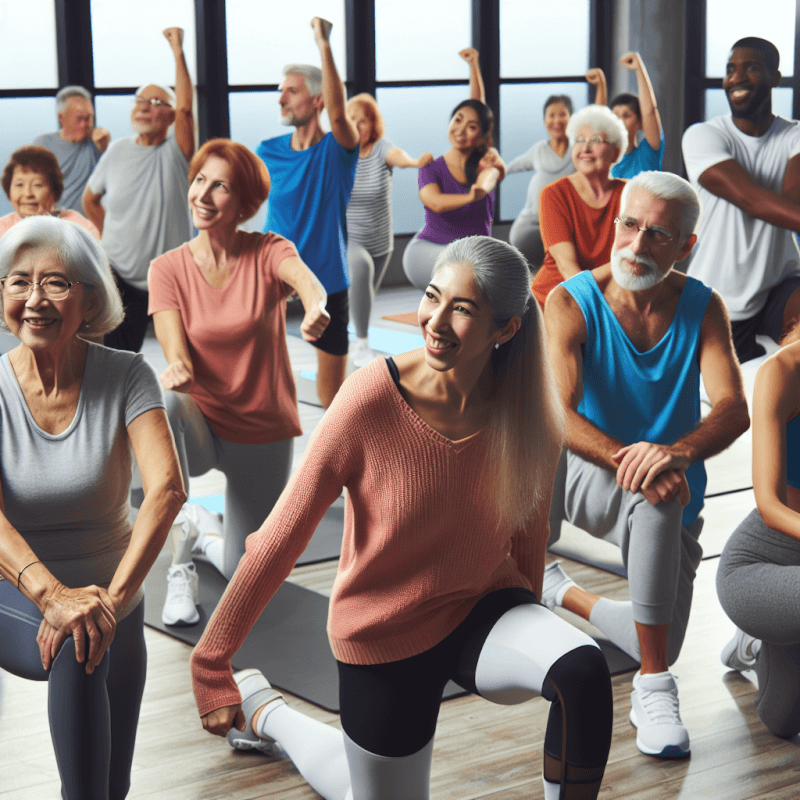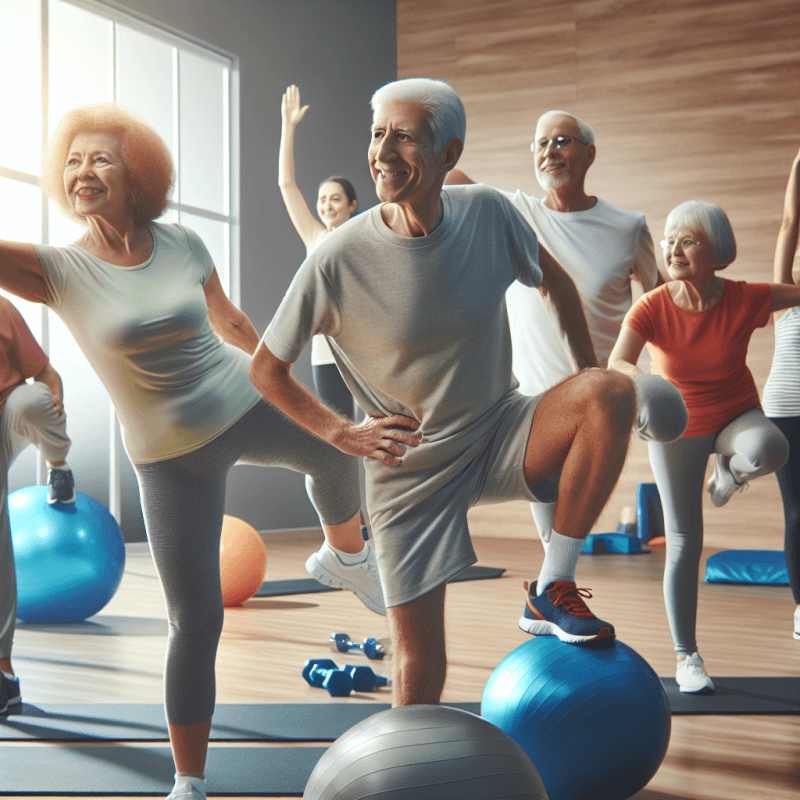Are you looking for a fun and effective way to stay fit as you grow older? Group fitness classes might just be the solution you’ve been searching for! From increased physical strength to enhanced mental well-being, these classes offer a myriad of benefits for older adults. Not only do they provide a social environment where you can connect with like-minded individuals, but they also offer professional guidance and motivation to help you reach your fitness goals. Whether you’re seeking to improve your balance, flexibility, or cardiovascular health, group fitness classes cater to a wide range of needs and abilities. So why not grab a workout buddy and join a class today? Your body and mind will thank you for it!

Improved Physical Health
Increased cardiovascular fitness
Engaging in group fitness classes for older adults can greatly improve cardiovascular fitness. These classes typically involve activities that increase heart rate and get the blood pumping, such as aerobic exercises, dance routines, and interval training. Regular participation in these classes can help strengthen the heart and improve its efficiency in delivering oxygen and nutrients to the body’s muscles.
Improved strength and flexibility
Group fitness classes also offer opportunities to improve strength and flexibility. Many classes incorporate resistance training exercises using weights, resistance bands, or bodyweight. These exercises help build muscle strength and improve bone density, reducing the risk of osteoporosis. Additionally, stretching exercises in these classes enhance flexibility, making daily tasks easier and reducing the risk of injuries.
Enhanced balance and coordination
As we age, our balance and coordination may decline, increasing the risk of falls. Group fitness classes for older adults often include exercises aimed at improving balance and coordination. These exercises may involve standing on one leg, tai chi movements, or specific drills focusing on stability. By regularly practicing these exercises, older adults can strengthen their muscles and improve overall balance and coordination, thus reducing the risk of falls and related injuries.
Reduced risk of chronic diseases
Regular participation in group fitness classes can also help reduce the risk of chronic diseases commonly associated with aging, such as cardiovascular diseases, diabetes, and certain types of cancer. The combination of cardiovascular activities, strength training, and flexibility exercises benefits the body by improving insulin sensitivity, reducing inflammation, and promoting overall health and well-being. Moreover, group fitness classes often emphasize the importance of proper nutrition, further supporting the prevention of chronic diseases.
Mental and Emotional Well-being
Reduced stress and anxiety
Participating in group fitness classes can provide significant mental and emotional benefits for older adults. Physical exercise has been proven to reduce stress and anxiety by releasing endorphins, which are known as “feel-good” chemicals. Engaging in a group setting can further enhance these benefits, as the social interaction and support from fellow participants can create a positive and uplifting environment.
Improved mood and self-esteem
Regular exercise through group fitness classes has shown to improve mood and self-esteem in older adults. The sense of accomplishment and progress achieved during each class can boost self-confidence and overall well-being. Additionally, the social component of these classes can help combat feelings of loneliness and isolation, leading to improved mood and a more positive outlook on life.
Increased brain function and cognitive abilities
Engaging in group fitness classes can also have positive effects on cognitive health. Physical exercise has been linked to improved brain function, including better memory, attention, and decision-making skills. The combination of physical activity, mental engagement, and social interaction in group fitness classes stimulates the brain, promoting neuroplasticity and potentially reducing the risk of cognitive decline and age-related conditions such as dementia.
Social Interaction
Opportunity for socialization
One of the major benefits of group fitness classes for older adults is the opportunity for socialization. These classes provide a welcoming and inclusive environment where participants can connect with others who share similar interests and goals. Building relationships with fellow class members can foster a sense of camaraderie and create a support system that extends beyond the confines of the workout setting.
Sense of belonging and community
Participating in group fitness classes can also foster a sense of belonging and community. The regular interaction with like-minded individuals who are on a similar fitness journey creates a supportive atmosphere where everyone feels valued and included. This sense of community can have a profound impact on mental well-being and overall life satisfaction.
Motivation and accountability
In a group fitness class, individuals often find motivation and accountability through the group dynamic. Seeing others working hard and achieving their goals can inspire and push individuals to challenge themselves. Additionally, the presence of a dedicated instructor and supportive peers can provide the necessary motivation and encouragement to stay committed to regular exercise.
Professional Guidance
Access to expert trainers
Group fitness classes for older adults are typically led by certified trainers who specialize in working with this population. These professionals have the knowledge and expertise to design safe and effective exercise programs that cater to the specific needs and abilities of older adults. They can provide guidance on proper form, technique, and modifications, ensuring a safe and beneficial workout experience.
Safety and injury prevention
Older adults may have specific considerations and physical limitations that need to be taken into account during exercise. Group fitness classes led by professional trainers prioritize safety and injury prevention. Trainers can supervise and correct participants’ movements to ensure proper execution and reduce the risk of injury. They can also provide alternatives or modifications to exercises that may be too challenging or risky for certain individuals.
Customized exercise programs
Another advantage of group fitness classes for older adults is the customization of exercise programs. Trainers can tailor workouts to the various fitness levels and individual goals of class participants. Whether someone is just starting their fitness journey or looking to take their workouts to the next level, trainers can adapt exercises, intensity, and intensity to meet each person’s specific needs, ensuring that everyone has an enjoyable and challenging workout.

Variety and Fun
Engaging and enjoyable workouts
Group fitness classes offer a wide range of workouts, making it easier for older adults to find activities they enjoy. From dance-based classes to circuit training and everything in between, there is something for everyone. This variety keeps workouts interesting and motivating, preventing boredom and providing a fresh and enjoyable experience with each session.
Opportunity to try new activities
Group fitness classes often introduce participants to new activities and exercise modalities they may not have considered on their own. Trying new things can be exciting and rejuvenating, opening doors to discovering new passions and interests. Whether it’s trying out a yoga class, learning a martial art, or experiencing a high-energy dance workout, older adults can expand their horizons and add diversity to their fitness routine.
Prevents exercise boredom
One of the challenges of maintaining an exercise routine is preventing boredom. Group fitness classes provide a solution to this by offering a variety of workouts and formats. The ever-changing nature of these classes keeps participants engaged and motivated, making it more likely that they will stick to their fitness goals and continue attending classes regularly.
Adaptability and Accessibility
Suitable for all fitness levels
Group fitness classes for older adults are designed to be inclusive and accommodating to individuals of all fitness levels. Whether someone is a beginner or has been exercising for years, these classes can be adjusted to meet each individual’s current abilities. Trainers can offer modifications and alternatives to exercises, ensuring that everyone can participate and progress at their own pace.
Accommodates various physical limitations
Older adults may have specific physical limitations or conditions that need to be considered during exercise. Group fitness classes are often designed to accommodate these limitations. Trainers can provide modified exercises that mitigate stress on joints, enhance stability, or address specific mobility challenges. By adapting exercises to individual needs, these classes ensure that participants can engage in physical activity safely and comfortably.
Flexible class schedules
Group fitness classes for older adults typically offer flexible schedules to accommodate varying lifestyles and commitments. Whether someone prefers early morning classes, daytime options, or evening sessions, there is likely to be a class that fits their schedule. This flexibility allows individuals to prioritize their health and fitness without disrupting other aspects of their daily lives.

Age-specific Focus
Tailored exercises for older adults
Group fitness classes for older adults are specifically designed to address the needs and challenges of aging. Exercises are chosen and modified to promote strength, balance, flexibility, and overall functional ability. Trainers understand the changes that occur in the body as we age and can design workouts that target the specific areas that need attention, ensuring that every participant can experience the benefits of exercise.
Addressing specific age-related challenges
In addition to tailored exercises, group fitness classes for older adults often address age-related challenges that may affect physical and mental well-being. These challenges may include joint stiffness, decreased range of motion, cognitive decline, and age-related chronic conditions. Trainers incorporate exercises and techniques aimed at alleviating these challenges, promoting better overall health and quality of life.
Promotes healthy aging
By focusing on the unique needs of older adults, group fitness classes promote healthy aging. Regular exercise in a supportive group environment can help maintain and improve physical and cognitive function, allowing individuals to stay active and independent as they age. Additionally, the social interaction and sense of community in these classes contribute to a positive outlook on aging and a greater appreciation for the benefits of leading an active lifestyle.
Motivation and Competition
Group dynamics and motivation
Participating in group fitness classes provides a unique opportunity to tap into the power of group dynamics. Working out alongside others who share similar goals and challenges can create a motivating and supportive environment. The energy and encouragement within the group can push individuals to give their best effort and reach their fitness potential, helping them stay motivated and committed to their exercise routine.
Friendly competition and teamwork
Group fitness classes may also incorporate elements of friendly competition and teamwork. Challenges or group activities during classes can create a sense of camaraderie and healthy competition among participants. This fosters a supportive and encouraging atmosphere where individuals push each other to excel, celebrate achievements together, and create lasting bonds.
Shared goals and achievements
In a group fitness setting, participants often share common goals and milestones. Whether it’s completing a certain number of workouts, achieving weight loss or strength goals, or even participating in group events or competitions, the shared experience of working towards these goals can be extremely motivating. Celebrating achievements together creates a sense of accomplishment and pride, reinforcing the benefits of group fitness classes.

Improved Sleep
Better sleep quality
Regular exercise has been shown to improve sleep quality, and group fitness classes are no exception. Engaging in physical activity, especially in a group setting, can help regulate sleep patterns and promote deeper, more restful sleep. The combination of physical exertion and the release of endorphins can calm the mind and body, making it easier to fall asleep and stay asleep throughout the night.
Regulated sleep patterns
Group fitness classes provide structure and routine, which can help regulate sleep patterns. By participating in classes at consistent times, the body’s internal clock becomes accustomed to the exercise schedule, promoting a more stable sleep-wake cycle. Establishing a regular exercise routine through group fitness classes can help regulate sleep patterns and improve overall sleep quality.
Reduced risk of insomnia
Insomnia, the inability to fall asleep or stay asleep, can be a common issue among older adults. Regular exercise has been shown to reduce the risk of insomnia, and group fitness classes provide an effective means of engaging in physical activity. The combination of the physical exertion during workouts and the mental and emotional benefits gained through socialization can help alleviate insomnia symptoms and promote better sleep.
Longevity and Independent Living
Increased life expectancy
Engaging in regular physical activity, such as group fitness classes, has been linked to increased life expectancy. Leading an active lifestyle supports cardiovascular and overall health, reduces the risk of chronic diseases, and promotes overall well-being. By participating in group fitness classes and making exercise a regular part of their routine, older adults can potentially extend their lifespan and enjoy more years of active and healthy living.
Enhanced functional ability
Group fitness classes for older adults place a strong emphasis on functional exercises that mimic the movements and activities performed in daily life. These exercises improve strength, flexibility, and coordination, allowing individuals to maintain and enhance their functional abilities. By improving functional ability, older adults can continue to engage in activities they enjoy and confidently carry out tasks necessary for independent living.
Maintained independence
Maintaining independence is a key concern for many older adults. Regular participation in group fitness classes can help preserve independence by improving physical health, mental well-being, and functional ability. The enhanced strength, balance, and coordination gained through these classes reduce the risk of falls and injuries, enabling older adults to maintain their autonomy and continue living independently.
In conclusion, group fitness classes offer numerous benefits for older adults. From improved physical health and mental well-being to social interaction and professional guidance, these classes cater to the unique needs and goals of this population. Whether it’s through cardiovascular activities, strength training, flexibility exercises, or tailored workouts for specific age-related challenges, participating in group fitness classes can enhance overall quality of life for older adults. So why not take the first step towards a healthier and happier life by joining a group fitness class today? Your mind, body, and social well-being will thank you!



